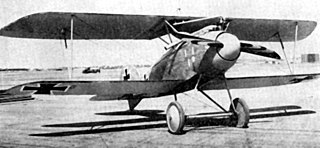| August Burkard | |
|---|---|
| Born | Unknown |
| Died | Unknown |
| Allegiance | Germany |
| Service/ | Aviation |
| Rank | Leutnant |
| Unit | Jasta 29 |
| Awards | Iron Cross |
Leutnant August Burkard was a World War I flying ace credited with six aerial victories. [1]

World War I, also known as the First World War or the Great War, was a global war originating in Europe that lasted from 28 July 1914 to 11 November 1918. Contemporaneously described as "the war to end all wars", it led to the mobilisation of more than 70 million military personnel, including 60 million Europeans, making it one of the largest wars in history. It is also one of the deadliest conflicts in history, with an estimated nine million combatants and seven million civilian deaths as a direct result of the war, while resulting genocides and the 1918 influenza pandemic caused another 50 to 100 million deaths worldwide.

A flying ace, fighter ace or air ace is a military aviator credited with shooting down several enemy aircraft during aerial combat. The actual number of aerial victories required to officially qualify as an ace has varied, but is usually considered to be five or more.
On 1 June 1918, Burkard was posted to Jagdstaffel 29, [2] [3] a Fokker D.VII fighter squadron commanded by Harald Auffarth. [4] On the 27th, Burkard staked his first victory claim, which was unconfirmed. He also received the Iron Cross First Class that day. Subsequently, he would score six confirmed victories between 8 August and 16 October 1918. [2]

Royal Prussian Jagdstaffel 29, commonly abbreviated to Jasta 29, was a "hunting group" of the Luftstreitkräfte, the air arm of the Imperial German Army during World War I. The squadron would score 76 aerial victories during the war, at the cost of 13 of their pilots killed in action, two killed in flying accidents, 12 wounded in action, one injured in a flying accident and one taken prisoner.

The Fokker D.VII was a German World War I fighter aircraft designed by Reinhold Platz of the Fokker-Flugzeugwerke. Germany produced around 3,300 D.VII aircraft in the second half of 1918. In service with the Luftstreitkräfte, the D.VII quickly proved itself to be a formidable aircraft. The Armistice ending the war specifically required Germany to surrender all D.VIIs to the Allies. Surviving aircraft saw much service with many countries in the years after World War I.

Eduard Florus Harald Auffarth Royal House Order of Hohenzollern, Iron Cross, Silver Wound Badge, Hanseatic Cross, was a World War I German fighter ace credited with 29 victories. After the war, he ran an aviation training school that covertly supported establishment of the Luftwaffe.


